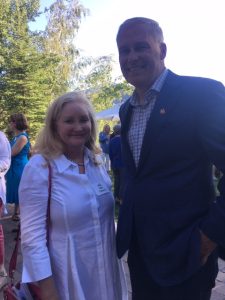Blaine County-owned solar projects
 Climate champions like Jay Inslee and me see opportunity in the new energy reality. Solar power costs have come down so dramatically that an average homeowner could save $400-$600 per year in getting their power from a community solar project. In a community solar project, individual homeowners, rather than going through the expense of putting a solar array on their own roofs, let someone else build a lot of solar in one big project less expensively and the homeowner commits upfront as a subscriber to take a share of the power coming from the solar plant to offset their own residential power use.
Climate champions like Jay Inslee and me see opportunity in the new energy reality. Solar power costs have come down so dramatically that an average homeowner could save $400-$600 per year in getting their power from a community solar project. In a community solar project, individual homeowners, rather than going through the expense of putting a solar array on their own roofs, let someone else build a lot of solar in one big project less expensively and the homeowner commits upfront as a subscriber to take a share of the power coming from the solar plant to offset their own residential power use.
The average residence uses about 11,000 kWh (kilowatt hours) per year and people may not know that the more power you use in Idaho, the higher rate you pay. On my current summer bill, the first 800 kWh of electricity per month my house uses costs 8.54¢ per kWh and the next 800 kWh cost 10.27¢ per kWh. (Which is why changing out light bulbs, installing insulation, and sealing up leaky windows really makes a difference in your bill—energy efficiency helps to keep you in the lower rate.)
Most community projects are designed so that homeowners get a savings from cheaper solar power; 2-4¢ solar power replaces kilowatt for kilowatt a homeowner’s residential 8-11¢ power use. The homeowner doesn’t get those actual electrons, as the solar power gets put onto the transmission wires with a mix of other generation sources, but the utility keeps track of the kilowatt-hours the homeowner generated at the community solar plant power and deducts those kilowatt-hours from your monthly home electrical bill.
In Idaho, city and county governments can be owners in power projects. There is a community solar project proposed at the county’s Glendale Road and Bridge site, for, I believe, $1 per year rent to the county. But if Blaine County did this community solar project themselves, either at this site or Ohio Gulch, it could create savings in the county budget and for homeowners.
I added up Blaine County’s 2019 departmental budgets for electricity, and it looks like the annual electrical bill for the county is about $117,000 at current retail rates. It would take a four-acre community solar farm generating just under 800 kilowatts of solar power to provide 100 percent of the county’s electricity consumption. It could also make the project a little bigger and have room in the project for homeowner subscribers to buy power at a saving compared to their current electricity rates. Maybe there can be a slice of the project reserved for low-income homeowners at even lower rates. I believe that it could also pre-sell subscriptions to those homeowners who wanted to help the county finance the project. Imagine if we help cities, who have the sewer plants’ high energy use, as well be a part of these projects; they can find savings for their cities as well.
 Due to Idaho state restrictions, the county makes a modest level of return on its cash reserves. I have read through the county’s audited financials and have asked many questions of our treasurer and clerk to understand the county’s investment picture; annual returns on our reserves appear to be approximately a CD rate of return. With a community solar project, the county not only gets significant savings on its power bills, but it earns income from the homeowner subscribers; I have worked with community solar installers to model a project with current costs ($1.25-per-watt install cost) and I have found that there could be almost $100,000-$150,000 in positive cash flow difference to the county in building our own community solar project.
Due to Idaho state restrictions, the county makes a modest level of return on its cash reserves. I have read through the county’s audited financials and have asked many questions of our treasurer and clerk to understand the county’s investment picture; annual returns on our reserves appear to be approximately a CD rate of return. With a community solar project, the county not only gets significant savings on its power bills, but it earns income from the homeowner subscribers; I have worked with community solar installers to model a project with current costs ($1.25-per-watt install cost) and I have found that there could be almost $100,000-$150,000 in positive cash flow difference to the county in building our own community solar project.
Let’s do this!
https://en.wikipedia.org/wiki/Community_solar_farm
https://www.illinoissfa.com/programs/community-solar/

